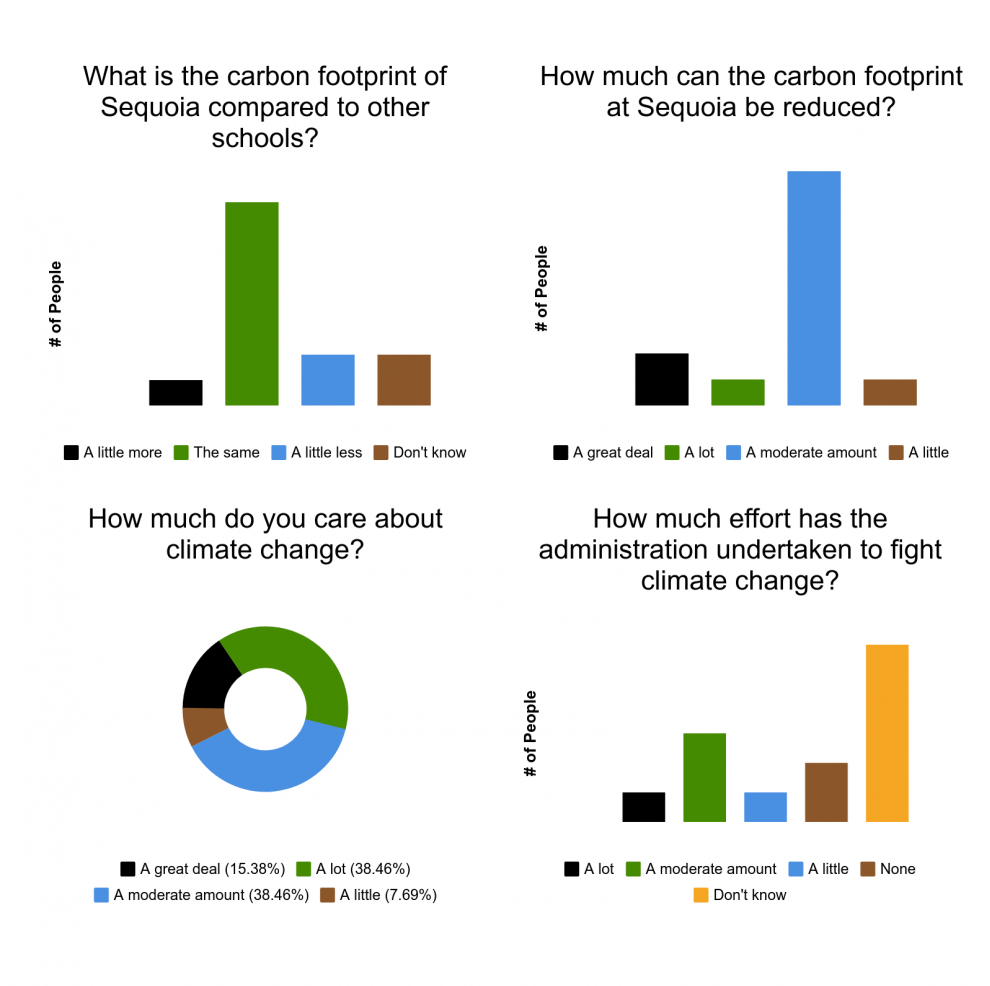The Heavy Feet of Sequoia
November 19, 2019
People are more active than ever before. From San Francisco to Mumbai, children and teens are mobilizing across the world to inspire action against climate change. At Sequoia too, students and teachers are making a change for a better, more eco-friendly school.
Every year, students produce greenhouse gases at Sequoia. From school events, student transportation and other practices, students produce a great amount of greenhouse gases that often goes unnoticed. Across the nation, steps are being taken to halt climate change and initiate climate action, but at a local level, things move much more slowly.
The popular opinion at Sequoia is that drastic changes are needed to stop the current plight of carbon emissions and climate change. But people don’t know how it would be implemented.
“I think both the carbon emissions and the trash that we produce first can be reduced. The biggest way of doing this would be altering the source of energy. Now, we rely on the energy grid that is being supplied. If we relied more on solar, we’re relying less on fossil fuels that are going to be releasing carbon dioxide.” said Jessica Magallanes, IB ESS teacher and advisor of the Sequoia Sustainability Project club.
However, the urgency of the crisis is argued. Some believe that it is a crisis with irreversible consequences, while others think that while it is a problem, it shouldn’t be in the forefront of our worries.

“I personally think the climate issue is more pressing. But I understand how challenging it is for change to happen in the public education system…we’re not just a school on our own, we consider the district and other funds…coming from this state,” Magallanes said.
Local levels usually can’t make big change without support from above, so it’s necessary to have that for any real action on global warming. In my opinion, the carbon footprint of Sequoia pales in comparison to the larger issues in America, but local issues are part of the problem that America faces as a whole. We all contribute to the greenhouse gas emissions, so every effort counts when it comes to reducing those emissions, no matter how small. However, one roadblock to climate action is people indifferent to the subject.
“I believe that some students simply don’t care about climate change because they can’t see how it affects them directly,” freshman Nicholas Kwok said.
It’s true that climate change isn’t often related to many concerns teens have, such as grades, friends, and their home lives. If it doesn’t affect them in a direct way, it makes sense that some students wouldn’t care about it. However, steps are being made to make that not true.
“One of the main ways to advocate for climate change activism is through the school system,” Magallanes said. “New [changes] at Sequoia are being made throughout the science curriculum that involve studying climate change and other world issues.”
If climate change is a question on someone’s test, that may warrant a little more attention and education on the issue. Another issue that climate change action faces is the budget, but Magallanes has a plan for that, too.
“What I would consider, is that we ask our local industries and private organizations that are looking to help us reduce the effects of climate change. By funding proactive initiatives, these organizations can get great PR and we benefit by reducing our carbon footprint! Maybe a startup downtown wants to fund new solar panels and get their logo and a plaque in return!”Magallanes said. Being inside the Bay Area grants Sequoia a unique opportunity to revolutionize carbon standards within the school.
But even outside of the bubble of the Bay Area, Magallanes’ proposal is already taking place across the United States and the world. For example, the University of Tucson in Arizona partnered with Tucson Electric Power to eliminate a third of all greenhouse emissions on campus. The school will receive its power from a wind farm in New Mexico and a solar array that hosts roughly 314,000 solar panels and an advanced storage system, according to Chamber Business News.
Also, Bristol University in the United Kingdom has decreased its carbon emissions by 27% since 2005 and plans to go carbon neutral by 2020 by collaborating with other companies. The Sequoia High School District has made no attempts such as these to halt climate change.
Even though it may be hard, Sequoia can reduce its carbon footprint through many ways. It currently uses outdated, inefficient power systems to fuel its everyday functions, such as water heaters, light fixtures, and older computers. Renovating these parts of Sequoia will definitely elevate its place in a new, eco-friendly school environment, and will catapult Sequoia into a new realm.






